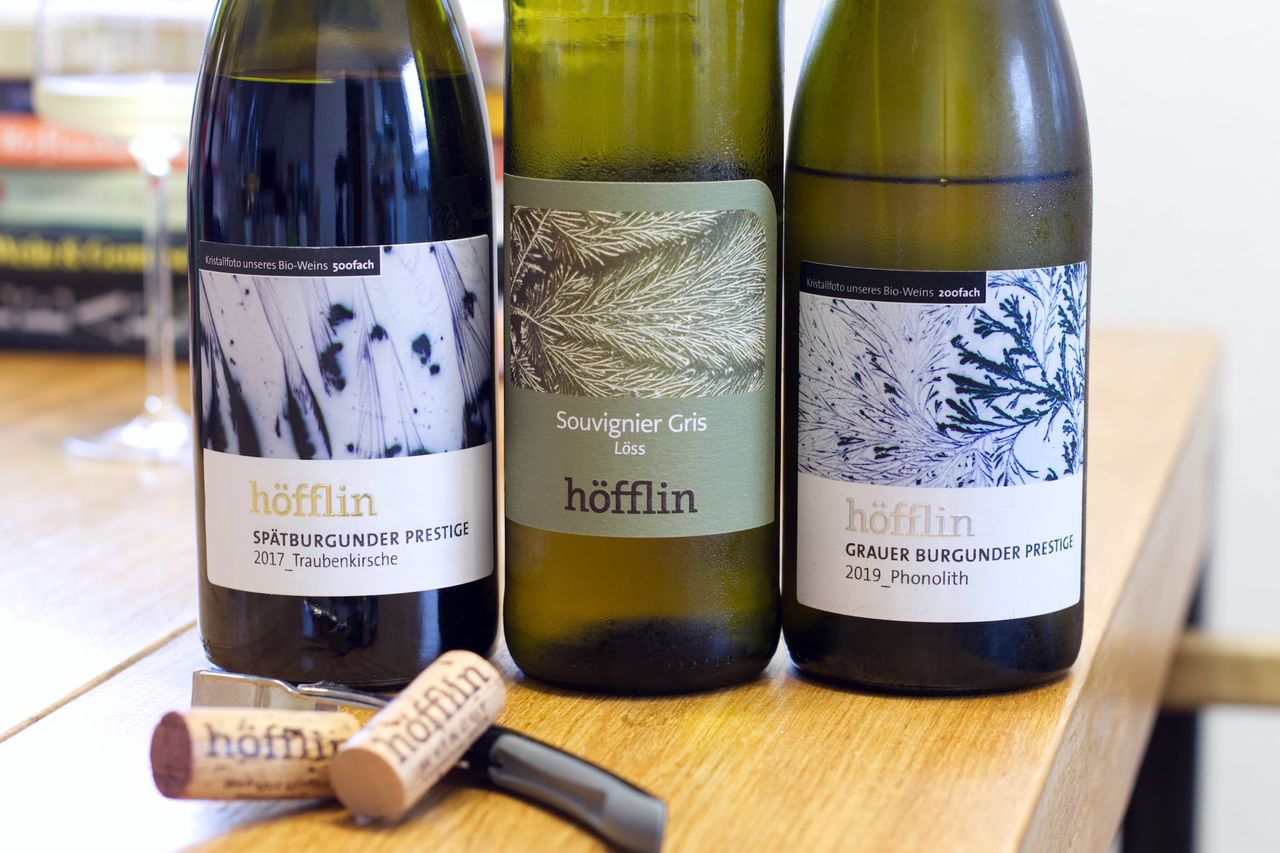Three Bottles Höfflin
We drink a bottle of Souvignier Gris 2022, a bottle of Pinot Gris Phonolith 2019 and a bottle of Pinot Noir Traubenkirsche 2017 from the Höfflin winery in Baden.

The crystal images on the labels are very stylish. I think that the order force and life information in these crystals are just ordinary physics, chemistry and biology, but that doesn’t make the pictures less attractive, rather the opposite. The underscores between the vintage and the wine names, however, were unnecessary for me, I have enough of those in my daily life when I do some programming. I prefer spaces on labels. I bought the wines from the Höfflin winery anyway. And partly because of the labels that is. Matthias Höfflin took over the farm in Bötzingen am Kaiserstuhl from his parents in 1987 and established the winery. Since his parents had been farming organically for many years, it was obvious that he would continue that way. In the warm Kaiserstuhl climate, the vines grow mainly on loess soils with various mixtures. The wines are all spontaneously fermented and processed with minimal intervention and then bottled with or without sulfur. Since all wines are bottled as Landwein, the locations on the labels cannot be mentioned and so there are Traubenkirsche or Phonolith instead of Schambach or Endhahle. The amount of wines they offer is quite large and besides the more classic wines there is also a more experimental line that we will save for next time. Today we try a Souvignier Gris 2022 from the base, I am always curious about PiWis anyway, a Grauburgunder Phonolith 2019 from the prestige single vineyard line and a Spätburgunder Traubenkirsche 2017.
The Souvignier Gris has about 11 grams of residual sugar and only 11.5% alcohol in the bottle. I have to admit that I didn’t read that before and I probably would have chosen a different wine otherwise. Prejudices and all. But that would have been a pity, because the first glass with the food was very good already. There was low-temperature cooked salmon, which had been marinated in an oriental way beforehand, and the pairing was just great. It has a lot of fruit and a nice spice in the nose. And on the palate there is apple, some fruit between yellow and orange and also the spice. It tastes like it smells. This is simple and tasty and as I have written a hundred times, this is not meant as an insult, as I never understood why tasty as an adjective for wine should be offensive. But maybe thats only the case for the German adjective lecker anyway and tasty is totally fine. I had Souvignier Gris mainly stored in my mind as a structure wine and this version is obviously not. Still, I am happy that I bought the wine.
The next day and without any food, the wine gets juicier. The structure fades even more and is replaced by a lot of apple and a honey note. This is also tasty, but the combination with the fish is hard to beat.
The Grauburgunder is quite a contrast program. There is so much spice in the wine that not much else happens at first. Plus a bit of wood and a very quiet fruit. This drinks much clearer than I had guessed after smelling. First acid, then comes tangerine and at the back caramel candy, which stays on the tongue forever. And when you have that in your mouth, then it also jumps into the nose, or was always there and only gets noticed now. This is special, but very nice.
Not much happens here overnight. I am still impressed by the dense spice in the smell and the clear freshness in the mouth. This is quite atypical Grauburgunder I would say, but then again almost all Grauburgunder I write about here are in one way or another exactly like that. For me, or at least for what I like in Grauburgunder, this might even be a pretty typical wine. A bit of canned fruit slowly manages to compete with the spice. You can definitely give this a shot, even if you don’t like Grauburgunder at all.
The Spätburgunder Traubenkirsche is quite subdued right after pulling the cork and therefore struggles to compete with the other two wines. It has red fruit, fine spice and a hint of Christmas in the aroma. I find that the wine smells somewhat dry, but not in terms of sugar content but in terms of dryness like dry grass or dry wood. But I can’t figure out what exactly gives that impression. The tannin is barely detectable, but that probably also adds to how juicy the wine is.
The wine then also undergoes the biggest transformation overnight of the three bottles. Remarkable, because as a 2017 vintage it already has some maturation behind it. It feels much more refined the next day, much more intense and structured. There is a touch of smoke, more cherry, which is also on the palate, and more juiciness. At the same time, the tannin has come alive and plays its role. The wine does not become a loudmouth at the fish market, but neither do the other wines and that is also good. Maybe the wine would also develop nicer crystals for the labels on the second day, who knows. I like it much more now.